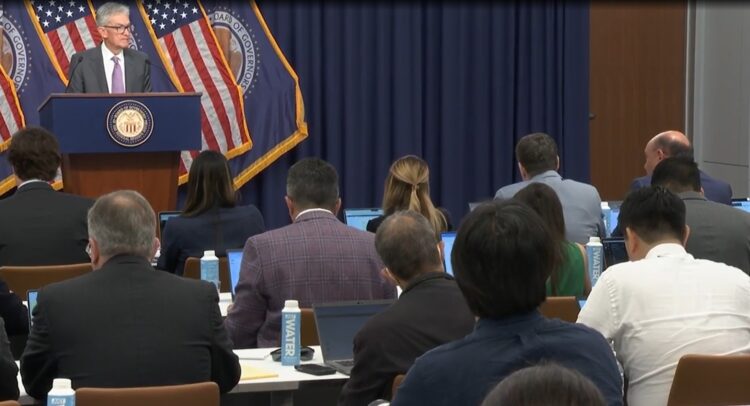The Federal Open Market Committee (FOMC) has three options at each meeting: lower the target Federal Funds Rate, raise it, or keep it unchanged. The market and media have been pushing for rate cuts that stimulate the economy, which we know can cause an uptrend in inflation. However, the Fed’s dual mandate focuses on maximum employment and low and stable inflation.
Claim 70% Off TipRanks This Holiday Season
- Unlock hedge-fund level data and powerful investing tools for smarter, sharper decisions
- Stay ahead of the market with the latest news and analysis and maximize your portfolio's potential
If employment remains historically high and inflation is above the Fed’s 2% target and trending downward, there’s certainly no rationale for raising it and no urgency for lowering it, especially if doing nothing gets the Fed where it wants to be.
The Fed wants to be at equilibrium, the place where prices are stable and employment is maximized.
Inflation Trends and Employment Stability
The FOMC statement after the July 2024 meeting acknowledges that inflation has eased but remains slightly elevated. The Committee’s goal is 2% inflation. A statement issued by the Fed said, “Inflation has eased over the past year but remains somewhat elevated.” This reflects a cautious optimism. Moreover, the Committee seeks to ensure that inflation moves sustainably toward its target before considering rate cuts. With inflation moving closer to 2%, even the most hawkish Fed official has stopped talking about raising rates further.
The employment rate, viewed as equally important for the Fed as inflation under the law, remains historically high despite some moderation. The FOMC states, “Job gains have moderated, and the unemployment rate has moved up but remains low.” The statement also explained that the stability reduces the urgency for rate adjustments, as the labor market does not show signs of significant stress.
So, there does not seem to be any urgency to take a more or less hawkish stance based on employment trends.
The Case Against Rate Cuts
Given the current economic conditions or near equilibrium, why wouldn’t the Fed resist cutting rates? The Fed has repeatedly emphasized the importance of data-driven decisions. The FOMC’s statement reads, “The Committee’s assessments will take into account a wide range of information, including readings on labor market conditions,” underscores this commitment.
Rate cuts are typically a response to weakening employment or significant economic downturns. With employment nearly stable and inflation nearing target levels, premature rate cuts could undermine progress.
Furthermore, Fed officials are wary of the potential inflationary effects of rate cuts. As mentioned in a recent CNBC article, the Fed is cautious about making changes that could disrupt the delicate balance achieved. The article quotes a financial analyst paraphrasing the Fed Chair saying, ” Why would we want to tinker with what we have right now?”
This sentiment ignores the buzz brought about by those who think an easing is a foregone conclusion. Instead, it reflects the Fed’s constant assertion that its primary concern is maintaining economic stability.
Waiting for the Soft Landing
A “soft landing” refers to the Fed’s ability to slow inflation without causing a significant economic downturn. This almost impossible balance requires patience and careful monitoring. The FOMC’s latest statement indicates a willingness to let this process play out, as they observe economic trends. “The Committee judges that the risks to achieving its employment and inflation goals continue to move into better balance,” reads the recent FOMC policy statement. This highlights a determination to maintain a cautious approach.
With steady employment and inflation decreasing, the Fed might opt to maintain current rates for several meetings. This strategy would disappoint those eager for rate cuts but aligns with the Fed’s long-term objectives. As Chair Powell noted, the Fed finds it more accessible to revive an economy than to squash inflation. He indicated a preference for maintaining a steady hand, erring on the side of being overly tight over erring on the side of moving to ease too soon.
Also, It is important to consider that the Fed Chair himself doesn’t know what future data will bring, and because of this, he’s less certain than the overly optimistic market what September will bring.
Key Takeaways
The Federal Reserve’s monetary policy-making committee has three choices at each FOMC meeting: lower the target Fed Funds Rate, raise it, or keep it unchanged. The market and media have been pushing for rate cuts that could keep stocks roaring. With inflation easing towards the 2% target and employment stable, there’s little urgency for rate changes.
The Fed’s data-driven decisions focus on balancing maximum employment and stable inflation, aiming for a soft landing without unnecessary rate adjustments. Hence, the next FOMC meeting may disappoint those seeking rate cuts again, as the Fed prioritizes economic stability over rapid intervention.
















